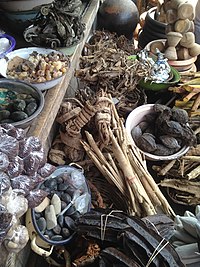
Photo from wikipedia
ETHNOPHARMACOLOGICAL RELEVANCE In South Africa, medicinal plants have a history of traditional use, with many species used for treating wounds. The scientific basis of such uses remains largely unexplored. AIM… Click to show full abstract
ETHNOPHARMACOLOGICAL RELEVANCE In South Africa, medicinal plants have a history of traditional use, with many species used for treating wounds. The scientific basis of such uses remains largely unexplored. AIM OF THE STUDY To screen South African plants used ethnomedicinally for wound healing based on their pro-angiogenic and wound healing activity, using transgenic zebrafish larvae and cell culture assays. MATERIALS AND METHODS South African medicinal plants used for wound healing were chosen according to literature. Dried plant material was extracted using six solvents of varying polarities. Pro-angiogenesis was assessed in vivo by observing morphological changes in sub-intestinal vessels after crude extract treatment of transgenic zebrafish larvae with vasculature-specific expression of a green fluorescent protein. Subsequently, the in vitro anti-inflammatory, fibroblast proliferation and collagen production effects of the plant extracts that were active in the zebrafish angiogenesis assay were investigated using murine macrophage (RAW 264.7) and human fibroblast (MRHF) cell lines. RESULTS Fourteen plants were extracted using six different solvents to yield 84 extracts and the non-toxic (n = 72) were initially screened for pro-angiogenic activity in the zebrafish assay. Of these plant species, extracts of Lobostemon fruticosus, Scabiosa columbaria and Cotyledon orbiculata exhibited good activity in a concentration-dependent manner. All active extracts showed negligible in vitro toxicity using the MTT assay. Lobostemon fruticosus and Scabiosa columbaria extracts showed noteworthy anti-inflammatory activity in RAW 264.7 macrophages. The acetone extract of Lobostemon fruticosus stimulated the most collagen production at 122% above control values using the MRHF cell line, while all four of the selected extracts significantly stimulated cellular proliferation in vitro in the MRHF cell line. CONCLUSIONS The screening of the selected plant species provided valuable preliminary information validating the use of some of the plants in traditional medicine used for wound healing in South Africa. This study is the first to discover through an evidence-based pharmacology approach the wound healing properties of such plant species using the zebrafish as an in vivo model.
Journal Title: Journal of ethnopharmacology
Year Published: 2021
Link to full text (if available)
Share on Social Media: Sign Up to like & get
recommendations!